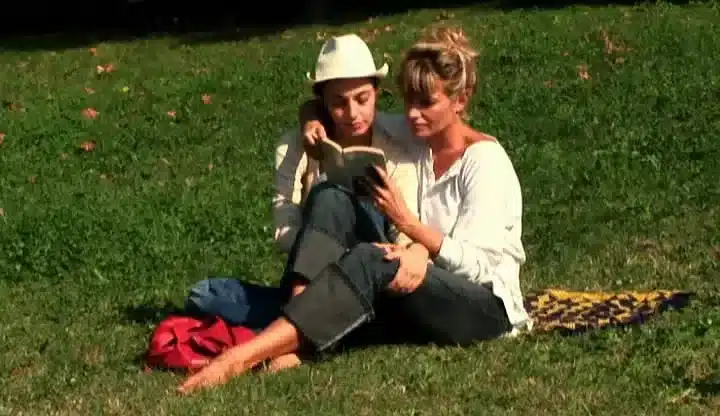Senza fine is a highly personal narrative of love, illness, and hope between two women who desire nothing more than to start a family. It takes place in Italy, where societal and legal hurdles make things quiet. The movie shows closeness in looks, gestures, and the quiet of waiting rooms without any showy language or big statements.

This is one of those rare lesbian movies that shows life as it really is on screen. Giulia and Chiara’s relationship never feels forced or fake, even when they have to deal with legal problems and sudden sickness. Senza fine is more than just a movie about queer love. It also shows how people can care for each other and choose to stay, even when the future is unknown. The cinematography is poetic and the sense of realism is strong.
Senza fine Official Trailer
Giulia and Chiara, a longtime lesbian couple in Italy, want to have a child together. But under Italian law, only heterosexual couples are allowed to pursue this dream. The two decide to travel to the Netherlands in hopes of completing the process there. As they wait in anticipation, Chiara is suddenly diagnosed with breast cancer, sending their plans—and emotions—into turmoil.


Giulia is a confident and warm-hearted woman who dreams of starting a family with her partner Chiara. She anchors the relationship with her optimism, until an unexpected medical diagnosis tests their bond.
Cristina Serafini
Cristina Serafini was born in Turin, Italy, and is the daughter of a journalist and a restaurant owner. She studied at the Scuola del Teatro Stabile di Torino, a prestigious drama school founded by Luca Ronconi. Fluent in Italian, English, French, and Spanish, Serafini has appeared in over 30 film and TV productions. Her breakout role was in Senza fine, which earned her critical acclaim and the Best Actress in a Leading Role Award at the 2009 Chieti Film Festival. She later starred alongside Alessandro Gassmann in Un Natale per due and was honored as Best Rising Italian Actress at the International Euro-Mediterranean Awards in Rome.

Chiara is quieter and more introspective than Giulia, but deeply devoted. Her breast cancer diagnosis turns their shared dream of having a child into a quiet confrontation with mortality, love, and resilience.
Irene Ivaldi
Irene Ivaldi brings emotional subtlety to the role of Chiara. Though less widely known internationally, her grounded and naturalistic performance in Senza fine has been praised for its raw vulnerability and understated grace. She has worked extensively in Italian theatre and independent cinema, portraying complex female characters with integrity and depth.
Director

Roberta Torre
An Italian filmmaker known for pushing narrative boundaries and exploring underrepresented identities in her work. Torre rose to prominence with Tano da morire (1997), a musical film that earned her acclaim at Venice Film Festival. In Senza fine, she turns her lens toward queer domesticity, illness, and resilience—treating each subject with sensitivity and stylistic elegance.
Her visual style often blends realism with lyrical abstraction, and that’s exactly what elevates this small-scale story into something quietly powerful.MOVIE HIGHLIGHT
Emotion Through Music
The near-constant soundtrack might overwhelm some viewers, but it effectively externalizes emotion where dialogue falls silent.
Cinematography as Inner World
Documentary-style close-ups and muted tones echo the suffocating reality of waiting rooms and cancer wards, while also capturing moments of raw intimacy.
Subtle Yet Political
Without lecturing, the film spotlights the bureaucratic and emotional hurdles faced by same-sex couples in conservative societies.
Ending on Light
The final scenes shift in tone, bathing the characters in warm light. It’s a visual metaphor for survival—not necessarily triumph, but endurance.
Senza fine Review
Review



Senza fine may be soft in plot, but it’s incredibly rich in emotion. There’s hardly any dialogue, and instead, the film lets you feel everything through meticulous sound design and a hauntingly poetic soundtrack. The cinematography leans toward documentary realism—tight close-ups, compressed frames, and dim color tones that evoke both intimacy and claustrophobia. It feels like watching someone’s private moments unfold, unfiltered and unpretentious.
What struck me the most was how ordinary it all felt—in the best way. There are no glamorous settings, no dramatic speeches—just two women trying to live, love, and hold on to hope. One scene that stayed with me is Chiara waking up in the hospital, smiling through tears when she sees Giulia beside her. It reminded me how the truest love often shows itself in the quietest moments.
The final sequence—with a sun-drenched atmosphere that feels suspended in time—was both nostalgic and hopeful. Yes, some might find the music a bit overused, and yes, the pacing borders on sluggish, but maybe that’s the point. Life doesn’t always move quickly, especially when you’re waiting—for answers, for healing, for a future together.
This film deserves more attention, especially in conversations around same-sex family rights. It’s the kind of quiet sunshine we need more of—one that dispels fear and prejudice, little by little.
